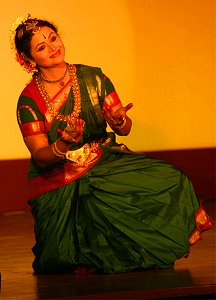
|
 |

|
 |
The role of Bhakti Bhava and Prema Bhava in dance: A dancer's quest - Padmaja Suresh, Bangalore e-mail: padmajasuresh@hotmail.com February 16, 2007 (Padmaja Suresh presented this paper on Feb 9 at the First International Indology Conference organized from 7-10 Feb 2007 at the Kala Academy, Goa. The theme of this conference was 'Ancient Wisdom Brought to Modern Times - Pathway to Higher Consciousness.')  The role of Prema - love and Bhakti - devotion is pivotal in divine dance forms like Bharatanatyam. The combination of Nritta (pure dance), Abhinaya (pure expression) and Nritya (expressional dancing) when portrayed in a spirit of total ecstasy, rising above the physical realm and parameters of the body shall lead the dancer close to the limitless domain of the COSMIC SELF. Such Natyopasana - devotional fervour - in dance wherein the dance assumes worshipful nature, leads to Natyabrahman - realizing the Universal within the individual self. A dancer uses his/her own personality comprising of physical form and mental states as the primary vehicle in the first stage, then enters or takes up the personality of the various characters represented as the secondary vehicle in the second stage, unwinds shackles of personal traits as the dance level develops and deepens and then finally he/she gets elevated to the highest spiritual sphere. In this relation, the relevant emotion and application of Bhakti and Prema Bhavas comes forth. In the Shastra, it is termed as Sringara - love; and is given the first place among Rasas -aesthetic flavours of dance and drama. Sringara is considered as the Rasa Raja - it rules literally because in it's portrayal alone is the inherent scope to touch upon other Bhavas too. Taking its three basic delineations as Vatsalya (Motherly affection), Rati (Union of male and female principles) and Bhakti (self-surrender and devotion to Lord Almighty), Sringara becomes delectable in any form whatsoever and offers the easiest path to be ONE with the ethereal world - Natya Yoga. But how? A dancer could be amply skilled and sincere too, but unless there is a sublimation of the ego, the dance cannot be effective in creating Rasanubhava, the impact of splendour. The dancer merges into the spirit of dance, surrenders to the magnificence of dance and spontaneously expresses a divine energy and this is when the audiences are also transported to similar experiences. Inspiration and intuition through dance follows both in dancer and the onlooker and irrespective of language or religious barriers, audiences can feel the divine energy. It is through the emotion-packed songs and lyrics, their exposition with portrayal of episodes, events, legends, historical characters and characteristics that the divine aura, ambience and vibrations are created for the audience to empathize totally and derive a fulfilling Rasa. The musicians and the dancers can thus become 'transmitters.' Negating the egoistic tendencies and considering oneself only as an instrument to experience divinity should be the aim of the dancer's quest. It is said that TRUE MOVEMENT CANNOT LIE. True joy would remain elusive if Bhakti or devotion and correspondingly, Prema or love to everyone and everything and everywhere is not felt and practiced. However, this cannot be always taught but can perhaps be imbibed in the contact of eminent gurus. Looking at the above process and essence of Natya, we can assess philosophical terms like Advaita, Vishishta Advaita and Dvaita. The concept of a dancer becoming one with the danced dance through Natya Yoga is principally and essentially holistic and Advaitic, while on the other hand, the aesthetic representation and appreciation of manifestations of divinity incorporated in dance are examples of admitting to theosophies like Vishishta Advaita. Again, the Bhakti-Marg (the pathway to God) prescribed by magnanimous saints from all over the world is so much suffused with infectious love, humble devotion and self-surrender, that dancing to their innumerable compositions (Keertanam) has the potency to infuse spiritual well-being. Creating, adding form (from Nirguna to Saguna) and placing this divinity on the highest pedestal become the right tools to communicate and a must for successful dramatic representation. Advaitam, True Shantam, resting in Monism can be the 'end' indeed where there cannot be any mundane expression but Natya in order to carry the dancer and spectators, has to be thoroughly expressive and appear world-related. It is multi-dimensional, physically externalizing through movement and emotions using eyes, parts of face, neck, limbs...and also all along internalizing by co-relating the mind. Above all, witnessing all these ephemeral states is 'the mystical eye' that can make one see the divine reality in the dance. Hence, one can understand the dance as LIFE itself... as cosmic movement ...as infinite cycle of creation, sustenance and destruction - THE REAL DANCE OF SHIVA! Bharatanatyam dancer/teacher Padmaja Suresh has been trained by prominent gurus in dance, music, choreography and nattuvangam. She hails from a family of renowned artistes - her great-grandfather Kalamandalam Maddalam Vengichen and father Chakyar Kootu K K Rajan. She holds degrees in Commerce, Law, Diploma in choreography from Guru Maya Rao's Natya Institute, a Masters in Philosophy and pursues a Doctorate at present. Her institution Kalpataru Kalavihar imparts training in classical dance and music and has a charitable wing Kalachaitanya for propagating arts for underprivileged children. |